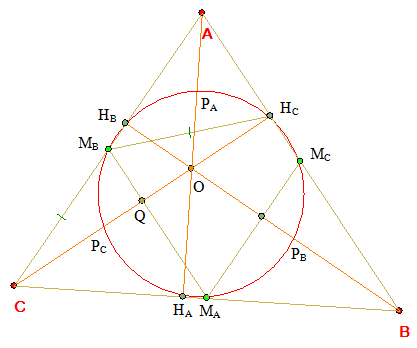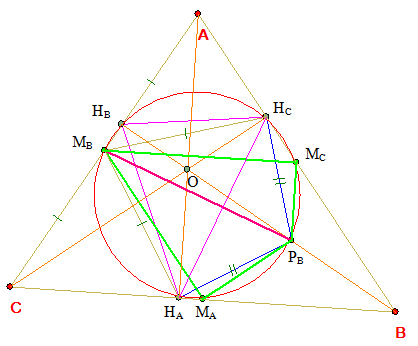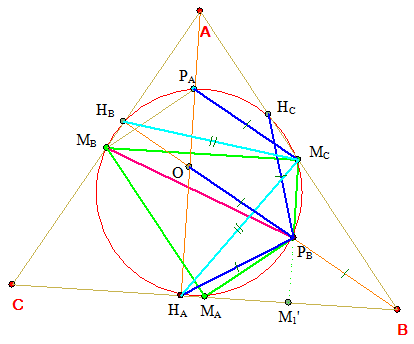Nine-Point Circle
One of the greatest occurrences in geometry is the Nine-Point Circle. This exercise will walk you through the proof of the Nine-Point Circle.
The Nine-Point Circle Explained
 |
The nine-point circle is an amazing circle that passes though the 3 feet of the altitudes and 3 feet of the medians. It also passes though PA, PB, and PC, which are the midpoints of AO, BO, and CO. |
Proof of the Altitudes
First, we'll prove that the cirlce that passes through the feet of the medians also passes through the feet of the altitudes. In other words, if we draw a circle that passes through the feet of the medians, then it will also pass through the feet of the altitudes. We'll use HC as an example and the others can be proved similarly.
We connect the points MB and HC. We first prove that CQ = QHC. Since MAMB is a segment that connects two medians, MAMB is parallel to AB. By using similar triangles CQMB and CHCA, it is easy to prove that:
(i) CQ = QHC
Also, since CHC is an altitude of triangle ABC, CQ is perpendicular to segment MAMB. Therefore,
(ii) ΔCHCMB is an isosceles triangle
Since triangle ΔCHCMB is an isosceles triangle, CMB = MBHC. We know that ∠CAB = ∠CMBQ because of parallel lines. This also means that ∠CMBQ = ∠QMBHC. Now, the medial triangle is similar to triangle ΔABC. This means that:
(iii) ∠QMBHC = ∠MAMBHC = ∠MCMAMB
Since CMB = MBA = b/2 and MAMC = b/2, the trapezoid HCMCMAMB is an isosceles trapezoid. We know that the vertices of an isosceles triangle lie on a circle. Thus, the circle that passes through ΔMAMBMC also passes through HC.
Similar conclusions can be made about points HA and HB.
The Diameter
 Triangle ΔHAHBHC (shown in magenta) is the orthic triangle. A property of orthic triangle holds that ∠HCHBPB = ∠HAHBPB. This becomes useful for proving that MBPB is the diameter of the nine-point circle.
Triangle ΔHAHBHC (shown in magenta) is the orthic triangle. A property of orthic triangle holds that ∠HCHBPB = ∠HAHBPB. This becomes useful for proving that MBPB is the diameter of the nine-point circle.We now will prove that MBPB is the diameter of the nine-point circle. In the process, we also prove that ΔMBMCPB is a right triangle, and ΔMBMAPB is a right triangle. If these two triangles are right triangles, then MBPB must be the diameter of the nine-point circle. To prove that these two are right triangles, we first prove that ΔHAPBHC is an isosceles triangle. We already know that ΔHAMBHC is an isosceles triangle.
Note that ΔHAHBHC is the orthic triangle. Therefore,
(iv) ∠HAHBPB = ∠HCHBPB
This means that HAPB = HCPB, and triangle ΔHAPBHC is an isosceles triangle. We also have ∠HAHBPB = ∠HAMBPB and ∠HCHBPB = ∠HCMBPB. Since ∠HAHBPB = ∠HCHBPB, ∠HAMBPB = ∠HCMBPB. This proves that MBPB is an angle bisector of ∠HAMBHC or that
(v) MBPB is a perpendicular bisector of ΔHAMBHC
This means that MBPB is the diameter of the nine-point circle and that ΔMBMAPB and ΔMBMCPB are right triangles.
Also, since MBMC is perpendicular to AHA, MCPB is parallel to AHA.
Last Three Points
Our next step is to prove that OPB = PBB.
 We already know that HCPB = HAPB. Now, ∠PAHAMC = ∠HAMCPB. This means that
We already know that HCPB = HAPB. Now, ∠PAHAMC = ∠HAMCPB. This means that
(vi) PAMC = HAPB
Since HBMC = HAMC, ∠HBPBMC = ∠HAPAMC. This proves that the quadrilateral PAMCPBO is a parallelogram. Thus,
(vii) PAMC = OPB
Notice that HAMC is a median of ΔAHAB. As stated earlier, MCPB (or MCM1') is parallel to AHA. This proves that
(viii) OPB = PBB and MAM1' = M1'B.
The Radius of the Nine-point Circle
Now we wonder about the length of the radius of the nine-point circle. It turns out that the radius is exactly half of the radius of the circumcircle of ΔABC. First, we note that ΔPAPBPC is similar to ΔABC. The lengths of the sides of ΔPAPBPC are exactly half that of ΔABC. Therefore, the area of ΔPAPBPC is ¼ of ΔABC. The circumradius, R, of ΔABC is given by: $R=\frac{abc}{4K}$, where K is the area of ΔABC. The circumradius of ΔPAPBPC (denoted as RN) is given by: $R_{N}=\frac{\frac{a}{2}\cdot\frac{b}{2}\cdot\frac{c}{2}}{4\cdot\frac{1}{4}\cdot K}=\frac{abc}{8K}=\frac{1}{2}R$.
Medial Triangle Similarity
 Triangle ΔPAPBPC is also similar to the medial triangle. Its sides are parallel to ΔABC.
Triangle ΔPAPBPC is also similar to the medial triangle. Its sides are parallel to ΔABC.
Moreover, when its vertices are connected with the medians, the lines are parallel to the altitudes (this is shown in the figure above). These lines meet the sides halfway between the feet of the altitudes and the vertices.

